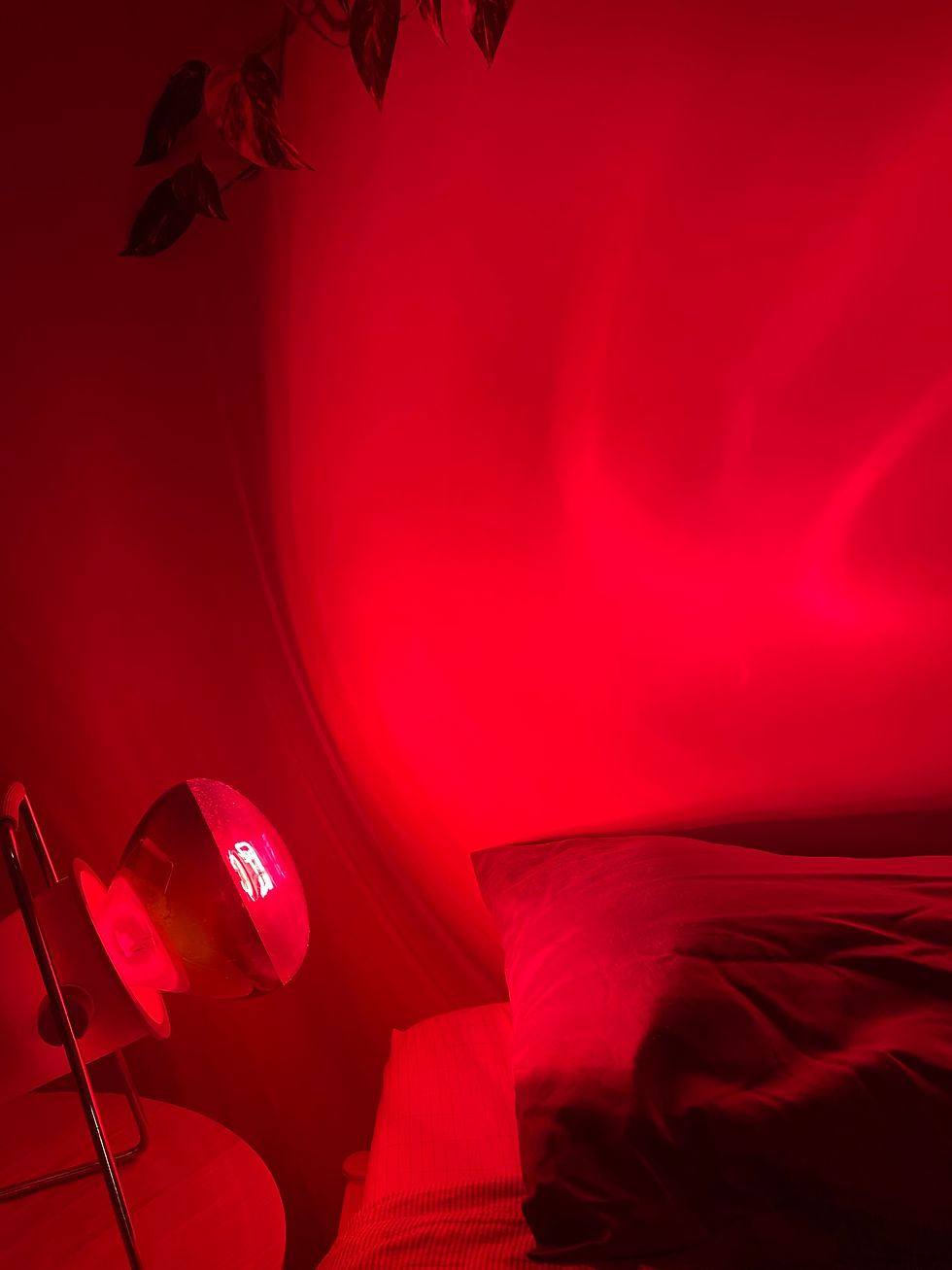Sometimes Red light means GO!
- Mathilde

- Jul 21, 2024
- 4 min read
Updated: Jul 29

Light therapy has become a popular trend lately, spanning various wellness and beauty practices. From skin care treatments in beauty salons to infrared saunas and hot yoga studios with infrared heat, the benefits of light therapy are being embraced for their potential to enhance health and well-being.
Light exposure plays a crucial role in maintaining the human body's health and well-being. From regulating our circadian rhythms, which govern our sleep-wake cycles, to boosting our mood and energy levels, the right type and timing of light exposure are essential for our overall physiological function. Proper light exposure can enhance cognitive performance, support immune function, and even impact hormone production.
Red light particularly plays a significant role in regulating the circadian rhythm.
Exposure to red light in the evening can help signal the body that it is time to prepare for sleep. Red light has a minimal impact on the suppression of melatonin, the hormone that regulates sleep, compared to blue light, which significantly suppresses melatonin production.
On the other hand, red light exposure in the morning can help reset the circadian rhythm, signalling to the body that it is time to wake up and be alert. This can enhance overall daytime alertness and cognitive function.
So what exactly is red light? And what is the difference between red light, infrared light (and infrared heat) and near infrared light.
Each type of light penetrates the skin to different depths and has unique properties that contribute to various therapeutic effects.
Red Light
Wavelength: 620-750 nm
Penetration Depth: 1-2 millimeters
Benefits:
Skin Health: Red light therapy is widely known for its skin rejuvenation properties. It stimulates collagen production, which helps reduce wrinkles and fine lines, improves skin texture, and promotes wound healing.
Anti-inflammatory Effects: Red light has been shown to reduce inflammation, making it beneficial for conditions like arthritis and other inflammatory disorders.
Pain Relief: It can alleviate pain by reducing inflammation and promoting blood circulation, which accelerates the healing process in injured tissues.
Red light is beneficial for treating acne and other skin conditions, reducing scars and stretch marks and enhancing muscle recovery post-exercise.
Infrared Light
Wavelength: 700-1,000 nm
Penetration Depth: 2-5 centimeters
Benefits:
Deeper Tissue Penetration: Infrared light penetrates deeper into the body than red light, making it effective for treating muscles, tendons, and bones.
Enhanced Circulation: It improves blood flow, which helps in the delivery of oxygen and nutrients to damaged tissues, promoting faster healing.
Pain Management: Infrared therapy is highly effective in managing chronic pain conditions such as fibromyalgia and lower back pain.
Infrared light is beneficial for alleviating chronic pain and inflammation, accelerating recovery from sports injuries and improving joint health.

Near-Infrared Light
Wavelength: 750-1,400 nm
Penetration Depth: 5-10 centimeters
Benefits:
Cellular Regeneration: Near-infrared light stimulates mitochondrial activity, leading to enhanced cellular energy production (ATP). This supports overall cellular repair and regeneration.
Wound Healing: It promotes faster wound healing by enhancing the production of growth factors and reducing oxidative stress.
Neurological Benefits: Near-infrared light has shown promise in improving cognitive function and reducing symptoms of neurodegenerative diseases like Alzheimer’s and Parkinson’s.
Near-Infrared light is beneficial for promoting brain health and cognitive function, enhancing muscle and joint recovery and supporting overall tissue regeneration.
So to summarise, red light is best for superficial skin treatments, reducing inflammation, and pain relief. Ideal for enhancing skin health and treating surface-level conditions. Infrared light penetrates deeper into the body, suitable for treating muscles and joints. It is particularly effective for chronic pain management and improving circulation.
Near-Infrared light penetrates the deepest, reaching muscles, bones, and even the brain. It is excellent for cellular regeneration, wound healing, and supporting neurological health.
How can you benefit from the light therapy in your everyday day life?
Once again, nature provides! The best natural red light is available for us EVERY day at sunrise and sunset. Exposing your skin to the first and last sun rays is one of the healthiest practice to boost your health and synch your circadian rhythm. It is no coincidence that rituals and ancestral practices are associated with this time of day.
Infrared light can be quite cheap. You can start with an old-fashion second hand infrared light or even build your own. I found mine on Marketplace and I am loving it. I use it at night in my bedroom or early in the morning during winter when it is still dark outside. Using the infrared light in a dark environment is key to prevent the distortion of the light rays. I use it to warm my body on my belly, legs or back, or to help with recovery post workout or during my cycle.
Infrared Sauna is a must-try if you haven't already! It has been quite popular lately with a lot of places, gyms and wellness centres offering this service. The infrared heat penetrates deeper under the skin layer, warming the body for inside out as a perfect way to release the toxins. This type of heat is also used in some hot yoga studios.
If you are considering light therapy, I encourage you to explore the different options available and find what works best for you. The healing potential of light is truly remarkable, and it has the power to improve not only your physical health but also your overall well-being.




Comments